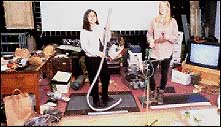|
 'We
did everything
that moved,' asserts Dennie Thorpe, who, along with Jana Vance, was
one of the Foley artists on the film. 'We
did everything
that moved,' asserts Dennie Thorpe, who, along with Jana Vance, was
one of the Foley artists on the film.
'You see, even if we're only going to use Foley in conjunction with
sound effects or production effects, we have to be there
when all of the production sound gets stripped out for the foreign versions.'
[Read about
foley at http://www.filmsound.org/terminology/foley.htm
]
Thorpe and Vance divided
the main characters between them; the former taking care of footsteps
and so forth for Anakin
Skywalker, Queen Amidala and Obi-Wan Kenobi, while the latter did the
same for Jar Jar Binks, Qui-Gon Jinn and Darth
Maul.
'With whatever we
do, we always want to convey that there's a reason for us to make a
specific sound,' says Thorpe.
'Obviously the actors are telling the story and there are certainly
production effects and other sounds cutting in and out, but
we're all working together to create a sort of translation of what you're
seeing into sound. For our part we had to deal with
plenty of wet, gushy sounds, metallic sounds, zingy sounds.
'For instance, there's
kind of a cute scene between Jar Jar and another character named Sebulba
that takes place in a
marketplace--Jar Jar sees all of this food, he gets hungry and wants
to take something, and in sort of slapstick fashion there's
this iron grille that the food is hanging off. There's very little happening
except for the characters' voices and what they're doing, and so we
were happy to be assigned the squeaks of the iron grille, as well as
other effects such as Jar Jar's tongue zinging out to grab a piece of
food, the food then flying through the air and splashing Sebulba as
chaos ensues. To that end Iwas crunching food, mashing my hand inside
a cut orange for the sloshing sounds, and flicking a metal Slinky inside
a box for some of the more zingy sounds. Added to that were the footsteps
and all of the other background stuff that we put in, helping to make
the whole scene come to life.
'By that time we'd already
gone out shopping and acquired all of our props, because on this film
we weren't completely set up
in the studio for everything. We looked at the film with Ben and with
our sound editors and Foley editors, and then Jana and I
went out shopping to various junk stores and recycling places for all
of the materials that we wanted. Then, in terms of the
recording, our top mic was a Neumann U87, and we used that in conjunction
with a PZM and a room mic, and Tony Eckert
mixed those three so that we could get perspective on our sound. That's
something we really like to do in Foley. We don't want it to sound like
it's in your face all of the time, and so as the characters walk through
the hangars and the palaces and the
courtyards their footsteps sound different on every surface.
'That worked very
well for us, a large part of the solution being the EQ that Tony came
up with.
Then, when the characters
were shot up or blown apart, we'd use various old vacuum cleaners, jacks,
drills and heavy pieces of iron, so that each head and arm and leg and
hand and maybe torso had a sound of its own. Added to that were the
sounds of the characters touching themselves or each other, and being
that a lot of them are not people we would use pineapples or coconuts
or even cantalopes for their skin surfaces.'
Dennie Thorpe also did
Foley work on Return of the Jedi back in 1983, a film in which C-3PO
had a somewhat more complete appearance than the skin-less, work-in-progress
look that he boasts in The Phantom Menace.
'He had a whole different
set of sounds in Jedi,' says Thorpe. 'For this movie we just ended up
using a large stainless steel salad bowl with wires, whereas in Jedi--where
you couldn't see inside of him--we manipulated ice trays along with
some other aluminium, metallic sounds. There again, in both films his
feet are complete, and so for those I used these really old-fashioned,
18-inch-long kid's skis that sound sort of like flippers when you put
them on and walk on the various surfaces.
'Foley can be a bit
mysterious when you're sitting up in the control room because you don't
know what we're using, but then
when people come down onto the Foley stage and see us work it appears
as if all we're doing is playing all day. They really like
that, while at our end we're sometimes wondering if our stuff is going
to cut through. However, the sound effects department
always leaves room for Foley--we've worked with those people for quite
a while now and they know what kind of things they
can leave to us.'
'We knew right from
the beginning what effects could do and what Foley could do,' adds Tom
Bellfort, 'and so the tracks
themselves were not as typically dense as on other movies. You know,
what happens frequently is that everybody duplicates
everybody else's work and then you throw it out, but that rarely happened
on this project.'
Excerpt from "Soundings from The Phantom Menace"
http://www.prostudio.com/studiosound/july99/post_phantom.html
|